
Therefore, if a patient has more than one metacarpal fracture, each has to be coded individually.
L1 compression fracture icd 10 code#
In essence, each ray has its own code set. The same can be said for the metatarsals and phalanges of the foot and toes. Fractures in the lower leg include fractures of the patella, the tibia and/or fibula, and the ankle.Īlso, in ICD-10, each of the metacarpals has its own code set, as do the phalanges of the thumb and fingers. Although most orthopaedic surgeons may think in terms of the radius and ulna, in ICD-10, fractures of the ulna are coded before fractures of the radius. Consequently, if both the radius and ulna, or the tibia and fibula, are fractured, each of the two bones has to be coded separately. ICD-10 does not have fracture codes that include both bones. In addition to codes for fractures of each bone in the forearm and lower leg, ICD-9 included codes that applied when both bones were fractured. The sequencing of codes progresses from superficial injuries, such as contusions or abrasions, to open wounds, such as lacerations with or without foreign bodies, then fractures, followed by subluxation and dislocations sprains injuries to the nerves injuries to blood vessels injuries of muscle, fascia, and/or tendons crushing injuries traumatic amputations and other injuries (which may include epiphyseal fractures when applied to the upper or lower extremities). In ICD-10, injury codes are regionalized to body sections such as shoulder and upper arm, elbow and forearm, or wrist, hand, and fingers. Associated injuries of the joint, such as subluxation or dislocation, or ligamentous injuries are coded secondarily in descending order of severity. When there is a combined injury, such as a bone injury/fracture that extends into a joint, the code applicable to the fracture is given the top priority. Even if the patient appears to have recovered, but is seen for a problem related to that original injury, albeit several years later, that final injury code has to be reactivated. When an injury code is established, particularly as it applies to fractures, the last code, with whichever seventh character is applied, remains with the patient forever. Because aftercare for fractures is built into the seventh character, the Z codes (Factors Influencing Health Status and Contact with Health Services, Z00-Z99) are not necessary for. These are particularly important with the initial coding for the fracture.ĭuring the course of follow-up care, the healing status of the fracture has to be adjusted in the code by changes in the seventh character. Fracture coding requires the use of many necessary descriptive terms open versus closed, displaced versus non-displaced, the fracture pattern, location in the bone (proximal, mid-portion, or distal), and laterality are all necessary. This would also be consistent with the concept of medical necessity.ĭocumentation for acute injuries and trauma has to be detailed extensively. If an electronic encounter form is used for the final diagnoses on the claim, the diagnoses have to be supported by the documentation in the records. Using these codes instead of very specific codes could cost you money. Even if the payer does accept them, payment may be reduced.

Do not use"Unspecified Codes" or"NOS (Not Otherwise Specified)" simply because they are not"specific." Insurers may not recognize these codes as legitimate, and as such, may not reimburse you for them. To achieve the highest specificity, particularly as it pertains to acute injuries, thorough and complete documentation is absolutely necessary. "Specificity" in diagnosis coding is the ultimate goal. The following bits and pieces of useful information for coders and physicians deserve discussion and definition.


 0 kommentar(er)
0 kommentar(er)
